
 |
JPL's Wireless Communication Reference WebsiteChapter: Wireless Channels
|
 | Figure: Example of impulse response and frequency transfer function of a multipath channel. |
In system evaluations, we typically prefer to address a class of channels with properties that are likely to be encountered, rather than one specific impulse response. Therefor we define the (local-mean) average power which is received with an excess delay that falls within the interval (T, T + dt). Such characterization for all T gives the "delay profile" of the channel.
The delay profile determines the frequency dispersion, that is, the extent to which the channel fading at two different frequencies f1 and f2 is correlated.
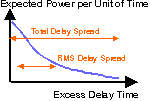
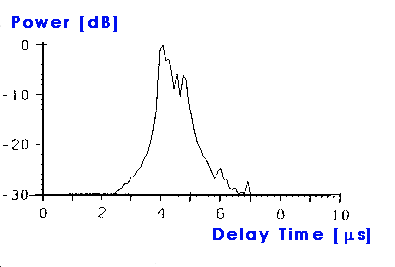
| Figure: Measured Delay profile in a German urban environment at 1800 MHz Delay Spread = 1.2 msec; coherence BW = 1.3 MHz Source: Research group of Prof. Paul Walter Baier, U. of Kaiserslautern, Germany. See also: corresponding scatter plot. |
|
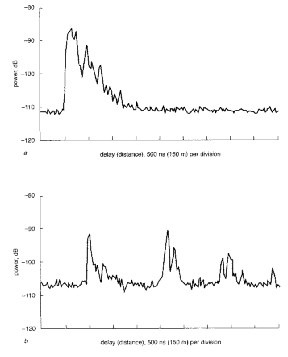 | Figure: Example of delay profile.
MP2 audio: Measured channel
data in Edinburgh. Source: Research group of Prof. Peter
Grant, U. of Edinbourough. See also: discussion of channel
modeling to study CDMA
array processing. |
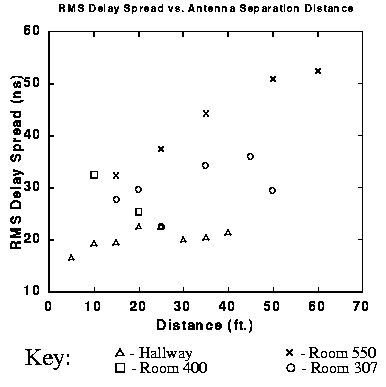
|
FIGURE: R.M.S. Delay Spread vs. propagation distance in the
U.C. Berkeley, Cory Hall Building. Source: John Davis and Jean-Paul Linnartz |
In indoor and micro-cellular channels, the delay spread is usually smaller, and rarely exceed a few hundred nanoseconds. Seidel and Rappaport reported delay spreads in four European cities of less than 8 microsec in macro-cellular channels, less than 2 microsec in micro-cellular channels, and between 50 and 300 ns in pico-cellular channels.
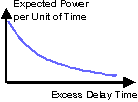
Figure: Typical delay profile: Exponential
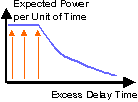
Figure: Typical indoor delay profile:
In an indoor environment, early reflections often arrive with almost identical power. This gives a fairly flat profile up to some point, and a tail of weaker reflections with larger excess delay.
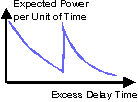
Figure: Typical "bad urban" delay profile
Besides the normal reflections from nearby obstacles (which cause reflection with a short excess delay), remote high-rise buildings cause strong reflections with large excess delay. The combined effects often result in multiple clusters of reflections.
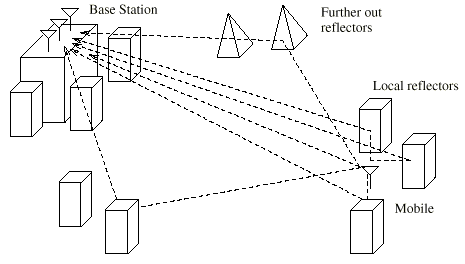 | Figure: Illustration of reflections of various kinds.
Source: Peter Grant, U. of Edinbourough. |
From the delay profile, one can compute the correlation of the fading at different carrier frequencies.

Figure Auto-Covariance of the received amplitude of
two carriers transmitted with certain frequency offset.
COST 207 Reference Models
The COST 207 project proposed reference models using the exponential profile with one or two decaying peaks. The model with two peak is similar to the above bad urban model.
| Urban, nonhilly: | exp(-t/1ms) | |
| Rural, nonhilly: | exp(-9.2 t/1ms) | |
| Bad urban, hilly: |
exp(-t/1ms)
0.5 exp(5-t/1ms) | for 0 < t < 5ms for 5 < t < 10ms |
| Hilly: |
exp(-3.5 t/1ms)
0.1 exp(15-t/1ms) | for 0 < t < 2ms for 15 < t < 20ms |
The above expressions only represent the behavior of the profile curve.
A correction factor is needed to ensure that the integral over all t equals unity, or to represent the total local-mean power.
Resolvable Paths
A wideband signal with symbol duration Tc (or a direct sequence (DS)-CDMA
signal with chip time Tc), can "resolve"
the time dispersion of the channel with an accuracy of about
Tc.
For DS-CDMA, the number of resolvable paths is
TDelay
N = round (-------) + 1
Tchip
where round(x) is the largest integer value smaller than x and TDelay is total
length of the delay profile.
A DS-CDMA Rake receiver can exploit N-fold
path diversity.
| System | Countermeasure | ||
| Analog |
| ||
| GSM |
| ||
| DECT |
| ||
| IS95 Cellular CDMA |
| ||
| Digital Audio Broadcasting |
|
Often propagation parameters are measured in frequency domain. Klaus Witrisal discusses how the delay spread can be estimated directly from a frequency transfer function.